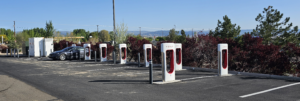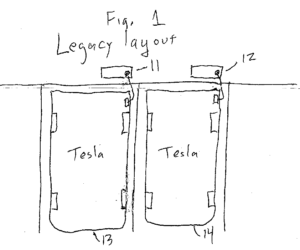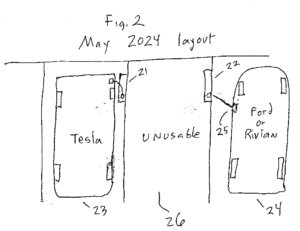
The Tesla company has quietly rolled out a new layout for superchargers, to better accommodate non-Tesla electric vehicles. Here you can see a brand-new supercharger station in Vernal, Utah.
The problem, of course, is that many non-Tesla EVs have their charging port in a very different place than Tesla cars. It works out well if a charging port is as close as possible to the front or back of the car. This permits a minimal-length charging cable to be used. Minimizing the length of the charging cable is not an idle concern, for at least two reasons:
-
- Liquid cooling. The charging cable is cooled along its entire length by a circulating liquid to keep it from getting too hot. It is helpful to keep the cable as short as possible to minimize the cost of this water-cooled cable.
- Expensive thick conductors. The cable has very thick electrical conductors to carry the very high currents used for fast charging. It is helpful to keep the cable as short as possible to minimize the cost of these expensive conductors.

Figure 1, at right, shows the legacy layout for a Tesla supercharging station. Each of the charging kiosks 11, 12 is at the end of its respective parking spot. This placement reduces the risk that a car will collide with the kiosk during the parking process. The Tesla car 13, 14 is backed into the parking spot. The charging port is behind the left rear wheel of the car. The charging cable can easily reach the charging port of the car.

Figure 2, at right, shows a new layout as seen in Vernal, Utah in May of 2024. (This supercharger station is at 2000 US-40. This is a V3 station offering speeds as fast as 250 kW, and it supports “plug and charge” for enrolled Ford and Rivian EVs.) As you may see in the photograph above, and in Figure 2, the charging kiosks 21, 22 are in a new location, each parallel to its parking spot. They kiosks are, of course, at greater risk of collision during the parking process.
In Figure 2, you can see a Tesla car 23 that has backed into a parking spot. The charging cable is able to reach the charging port at the left rear of the Tesla car.
Now consider the Ford or Rivian EV 24 that has parked nose-in. Despite the charging port being where it is (behind the left front wheel, adjacent to the driver’s door), the positioning of the kiosk 22 permits the charging cable 25 to reach the Ford or Rivian charging port. This is very good news for the Ford or Rivian EV owner who does not need to struggle to try to get the charging cable to reach the charging port.
Of course, this charging session renders parking spot 26 unusable for as long as the Ford or Rivian EV owner is using the charging plug. But at least this layout does permit the Ford or Rivian EV owner to make use of this Tesla supercharging station.